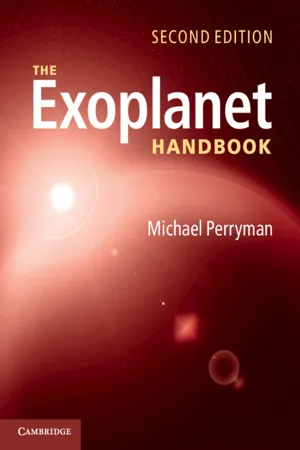The Exoplanet Handbook
About this book
With the discovery of planets beyond our solar system 25 years ago, exoplanet research has expanded dramatically, with new state-of-the-art ground-based and space-based missions dedicated to their discovery and characterisation. With more than 3, 500 exoplanets now known, the complexity of the discovery techniques, observations and physical characterisation have grown exponentially. This Handbook ties all these avenues of research together across a broad range of exoplanet science. Planet formation, exoplanet interiors and atmospheres, and habitability are discussed, providing in-depth coverage of our knowledge to date. Comprehensively updated from the first edition, it includes instrumental and observational developments, in-depth treatment of the new Kepler mission results and hot Jupiter atmospheric studies, and major updates on models of exoplanet formation. With extensive references to the research literature and appendices covering all individual exoplanet discoveries, it is a valuable reference to this exciting field for both incoming and established researchers.
Frequently asked questions
- Essential is ideal for learners and professionals who enjoy exploring a wide range of subjects. Access the Essential Library with 800,000+ trusted titles and best-sellers across business, personal growth, and the humanities. Includes unlimited reading time and Standard Read Aloud voice.
- Complete: Perfect for advanced learners and researchers needing full, unrestricted access. Unlock 1.4M+ books across hundreds of subjects, including academic and specialized titles. The Complete Plan also includes advanced features like Premium Read Aloud and Research Assistant.
Please note we cannot support devices running on iOS 13 and Android 7 or earlier. Learn more about using the app.
Information
Table of contents
- Cover
- Half-title page
- Reviews
- Title page
- Copyright page
- Contents
- Preface to the Second Edition
- 1 Introduction
- 2 Radial velocities
- 3 Astrometry
- 4 Timing
- 5 Microlensing
- 6 Transits
- 7 Imaging
- 8 Host stars
- 9 Brown dwarfs and free-floating planets
- 10 Formation and evolution
- 11 Interiors and atmospheres
- 12 The solar system
- Appendix A Numerical quantities
- Appendix B Notation and acronyms
- Appendix C Radial velocity exoplanets
- Appendix D Transiting exoplanets
- Appendix E Lensing exoplanets
- Appendix F Imaging exoplanets
- References
- Subject index
- Object index
